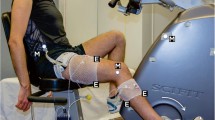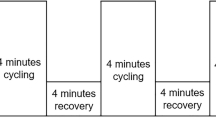Abstract
In the field of competitive cycling, non-traumatic injuries arising from muscle fatigue have been recognized as a significant problem. Although muscle coordination of the lower extremities is key to achieve high efficiency in pedaling, only a few prior studies have quantified the bilateral coordination of both legs. This quantification could contribute to the understanding of how enhanced pedaling skills may help to reduce muscle fatigue. The aim of this study was to investigate the mechanism underlying inter-lower limb coordination, which should serve to extend the understanding of pedaling skills further. First, 11 healthy males were instructed to pedal for 30 s under a 150-W exercise load and at cadences of 70, 90, and 110 rpm. Next, we investigated the synergistic activity—known as muscle synergy—of both the left and right legs based on the time frequency components of surface electromyography, along with the crank rotation angle during the pedaling exercise. The results indicate that the muscle synergy of bilateral muscle coordination reflects the motor adaptation to pedaling rate during cycling, and the functional roles of the left and right legs differ with changes in cadence and cycling experience. In conclusion, the motor control mechanism underlying pedaling skills is explained by the bilateral muscle coordination related to actions, such as pushing a pedal down using one leg, while pulling the other pedal up using the other leg during pedaling. This conclusion casts doubt on investigations into the efficiency of the pedaling done by a single leg.






Similar content being viewed by others
References
Dettori NJ, Norvell DC (2006) Non-traumatic bicycle injuries: a review of the literature. Sports Med 36(1):7–18
Asmussen E (1979) Muscle fatigue. Med Sci Sports Exerc 11(4):313–321
Korff T, Romer LM, Mayhew I, Martin JC (2007) Effect of pedaling technique on mechanical effectiveness and efficiency in cyclists. Med Sci Sports Exerc 39(6):991–995
Hug F, Dorel S (2009) Electromyographic analysis of pedaling: a review. J Electromyogr Kines 19(2):182–198
Sato T, Tokuyasu T (2017) Pedaling skill training system with visual feedback of muscle activity pattern. J Biomech Sci Eng 12(4):17–00234
Hug F, Turpin NA, Guével A, Dorel S (2010) Is interindividual variability of EMG patterns in trained cyclists related to different muscle synergies? J Appl Physiol 108(6):1727–1736
D’Avella A, Saltiel P, Bizzi E (2003) Combinations of muscle synergies in the construction of a natural motor behavior. Nat Neurosci 6(3):300–308
Hug F, Turpin NA, Couturier A, Dorel S (2011) Consistency of muscle synergies during pedaling across different mechanical constraints. J Neurophysiol 106(1):91–103
Blake OM, Wakeling JM (2015) Muscle coordination limits efficiency and power output of human limb movement under a wide range of mechanical demands. J Neurophysiol 114(6):3283–3295
Hermie JH, Bart F, Roberto M, et al (1999) SENIAM: European recommendations for surface electromyography. Enschede, The Netherlands
Karlsson JY, Akay M (2000) Time–frequency analysis of myoelectric signals during dynamic contractions: a comparative study. IEEE Trans Biomed Eng 47(2):228–238
Dingwell J, Joubert J, Diefenthaeler F, Trinity J (2008) Changes in muscle activity and kinematics of highly trained cyclists during fatigue. IEEE Trans Biomed Eng 55(11):2666–2674
Tscharner VV (2000) Intensity analysis in time-frequency space of surface myoelectric signals by wavelets of specified resolution. J Electromyogr Kines 10(6):433–445
Ortega-Auriol PA, Besier TF, Byblow WD, McMorland A (2018) Fatigue influences the recruitment, but not structure, of muscle synergies. Front Hum Neurosci 12:217. https://doi.org/10.3389/fnhum.2018.00217
Enders H, Maurer C, Baltich J, Nigg BM (2013) Task-oriented control of muscle coordination during cycling. Med Sci Sports Exerc 45(12):2298–2305
Taborri J, Agostini V, Artemiadis PK, Ghislieri M, Jacobs DA, Roh J, Rossi S (2018) Feasibility of muscle synergy outcomes in clinics, robotics, and sports: a systematic review. Appl Bionics Biomech 2018:3934968. https://doi.org/10.1155/2018/3934698
Patterson RP, Moreno MI (1990) Bicycle pedalling forces as a function of pedalling rate and power output. Med Sci Sports Exerc 22(4):512–516
Routson RL, Kautz SA, Neptune RR (2014) Modular organization across changing task demands in healthy and poststroke gait. Clin Neurophysiol 2(6):e12055
Clark DJ, Ting LH, Zajac FE, Neptune RR, Kautz SA (2010) Merging of healthy motor modules predicts reduced locomotor performance and muscle coordination complexity post-stroke. J Neurophysiol 103(2):844–857
Willian JK, Douglas AN (2003) Early skill learning is expressed through selection and tuning of cortically represented muscle synergies. J Neurosci 23(35):11255–11269
Author information
Authors and Affiliations
Corresponding author
Additional information
Publisher's Note
Springer Nature remains neutral with regard to jurisdictional claims in published maps and institutional affiliations.
About this article
Cite this article
Sato, T., Kurematsu, R., Shigetome, S. et al. Motor control mechanism underlying pedaling skills: an analysis of bilateral coordination in the lower extremities. Artif Life Robotics 25, 308–315 (2020). https://doi.org/10.1007/s10015-019-00580-8
Received:
Accepted:
Published:
Issue Date:
DOI: https://doi.org/10.1007/s10015-019-00580-8




